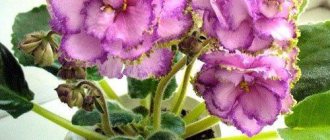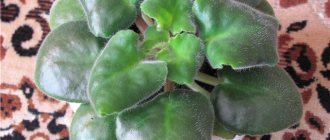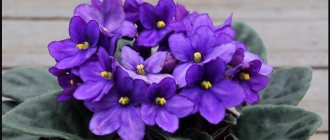Violets of any color are mysterious, mysterious, slightly mystical flowers , and lilac ones are no exception.
In this article we will talk about different varieties of lilac violets, which differ in shape, size, and shades.
Get acquainted with the information and advice from experienced flower growers, choose those that suit you , and photos of lilac violets will help you with this.
Energy of color
The popularization of violets has been in full swing lately. Thanks to the efforts of breeders, more and more people are decorating their homes with Saintpaulia . Beginning collectors are often afraid of failure when purchasing a particular variety.
The lilac violets described in the article are suitable for both beginners and experienced gardeners. What attracts these plants and why are they so popular?
The color range of lilac shades is large . There are not many of them in nature. Therefore, violets bred by creative and extraordinary people help bring harmony to the space of the house. It's warmer and more comfortable with them.
From all the variety of shapes - pansies, stars, bells, bowls, wasps - you can choose the one that suits you.
Terry, semi-double, simple, in the form of carnations or scalloped, with a border, fringe - they are equally beautiful and unique.
Lilac violets are fascinating, they have a mysterious energy that makes you kinder and calms you down. Chimeras and Saintpaulias with prints leave no one indifferent.
Important! It turns out that anyone can find a lilac Saintpaulia to their liking or create their own unique collection.
Diseases and pests
You can ensure a long life for a plant only if you follow the rules of plant care.
Failure to follow the recommendations will lead to damage to the plant and diseases:
- fusarium;
- powdery mildew;
- gray rot;
- rust;
- late blight;
- vascular bacteriosis.
[adsp-pro-6]
Diseases are treated by spraying with appropriate fungicides. Treatment must begin immediately, when the first signs of the disease appear. A violet severely affected by the disease cannot be saved.
In addition to diseases, numerous pests can cause harm to the plant:
- mites;
- aphid;
- scale insects and false scale insects;
- springtails;
- woodlice;
- nematodes;
- thrips;
- whiteflies;
- midges and mosquitoes.
To destroy pests, insecticides are used: Aktara, Aktellik, Alatar, etc.
Lilac violets
With border or spots
Stone Flower
The author of the original variety is Konstantin Morev. Saintpaulia grows slowly and loves natural light. The stone flower tolerates drought calmly. Forms sports.
The flowers are double and semi-double stars, up to 4 cm, the color is bright, raspberry-violet, the border is yellow-green. Petals have a dense structure.
The leaves are dark green, large, wavy. The socket is standard, symmetrical, even.
Attention! It blooms for a long time, does not form a hat, and produces few flower stalks.
Jan-Merilen
The author of the bright, rich variety is Natalya Puminova (Moscow). Saintpaulia pleases with cap blooms , often and in large quantities. Forms sports.
The flowers are large half bells, the color is lavender with a soft lilac tint, a bright blue fantasy pattern and a pink eye. The peduncles are strong and tall, holding 3-4 flowers.
The leaves are shiny, bright, light green. The socket is standard, smooth.
Shining stars
These mysterious and delicate lilac violets with a white border were created by Konstantin Morev.
Saintpaulias love good watering and sufficient natural light.
The flowers are very large stars up to 6 cm, the color is pastel lilac-violet, there is a white eye in the middle, and a corrugated white border along the edge of the petals. The flowers last for 2-3 weeks, but are classified as fallout. Peduncles grow tall and may bend slightly.
The leaves are medium green, with white variegation along the edges. The rosette is standard, large, with long petioles.
Summer twilight
The author of the unusually beautiful violet is Konstantin Morev .
Summer twilight - an unpretentious variety, blooms for a long time , at lower temperatures the border on the flowers becomes wider. Likes watering the soil from above or using a wick. Propagates easily , preferably by cuttings.
The flowers are large, 5-6 cm, double, color is lilac-violet, the eye is white, the edge of the velvet petals has a white border.
Peduncles are low and durable. Sometimes, due to the heaviness of the flowers, they may bend slightly downward.
Leaves are variegated and green. The socket is standard, looks smooth and neat.
Large-flowered
AV-Russian Style
The author of the elegant Saintpaulia is the Violet Maker (Alexey Tarasov, Moscow). Not capricious . Does not require special care.
The flowers are large stars with a diameter of up to 7 cm, double, the color is lilac-violet, with a slight flicker, the border is white and green. The petals are dense, elongated, with a waxy structure.
It blooms super profusely and forms a beautiful head. Short, strong peduncles hold flowers well.
Leaves are medium green. The socket is neat, looks compact, standard.
Lilac beauty
The author of this marvelous variety is the spouses Boris and Tatyana Makuni . Saintpaulia blooms powerfully, abundantly, for a long time. Does not require special care.
The flowers are large, graceful, fringed, the color is pale lilac, warm, the edging is thin dark purple, dark lilac dots are located closer to the center. Peduncles are strong.
The leaves are round in shape, slightly wavy along the edges, green, slightly elongated. Has a large socket.
Transfer rules and schedule
It is necessary to replant indoor violets annually in order to refresh the soil and inspect the root system. When replanting, the plant is removed from the pot and all dry and rotten parts of the rhizome are removed with a sharp knife.
Every year, Your Majesty’s violet is transplanted into a new pot.
Important. Before the procedure, the knife must be disinfected, and the cut areas are sprinkled with crushed charcoal. These actions will prevent the possibility of viruses, bacteria and fungus entering the root system.
When transplanting, you should adhere to the following rules:
- The soil for violets should be as loose, light, air- and water-permeable as possible. A ready-made substrate for violets with the addition of a small amount of vermiculite is ideal. You can prepare the soil yourself by mixing leaf and turf soil, peat, sand, and vermiculite.
- Small containers are used for transplanting. The diameter of the violet should be three times larger than the pot. Experienced gardeners do not recommend using old pots when replanting. It is preferable to plant violets in plastic containers. The size of the pot gradually increases as the horse system grows. The maximum diameter is 10 centimeters in diameter.
- Drainage consisting of expanded clay or small pebbles and sphagnum moss is placed at the bottom of the pot. The height of the drainage layer is 3-4 centimeters.
- When transplanting, the violet is buried in the soil to the level of the lower row of leaves. In this case, the leaves and cuttings should be slightly above the soil, barely touching it.
- After transplanting, you need to build a greenhouse over the plant from a plastic bag or plastic bottle. The cover is removed after 2 days. At this time, you can water the violet.
- The transplanted violet can be returned to its permanent growing location in 3-4 days.
For violets of the Your Majesty variety, small pots are chosen.
TOP 10 most popular varieties
AB-Fourth Dimension
An amazingly beautiful lilac violet with white fringe belongs to the selection of Violetkovod (Alexey Tarasov, Moscow).
The flowers are simple stars, the color is dark blue, with dark lilac fantasy, raspberry dusting and rare pink peas. Petals with a dense structure, a white border along the edge.
Peduncles are short and strong. The flowering is super abundant and lasts a long time.
The leaves are medium green, slightly toothed, and wavy. The socket is standard.
EK-Tibet
The author of the bright, contrasting variety is Elena Korshunova (Tolyatti). The name is inspired by the pre-dawn views of Tibet.
The flowers are very large, semi-double, the color is in the form of purple-violet spots on the petals, a white eye and a wide snow-white frill. The petals are wavy and airy.
Peduncles are slender and strong. The violet blooms wildly, the bouquet does not fall apart.
The leaves are deep green, round, and medium-sized. The socket is smooth and compact.
EK-Lilac aura
Exquisite, romantic light lilac violet from the collection of breeder Elena Korshunova (Togliatti).
Saintpaulia is not capricious , it is easy to tame and care for. In the first flowering it can be upsetting due to the untidy shape of the flowers. Don’t be upset; as you grow up, EK-Lilac aura will delight you with a first-class bouquet.
The flowers are large, 6 cm each, the color is iridescent lilac, with a purple eye. The fringed petals have a purple edge. It blooms with a beautiful hat. Peduncles are strong.
The leaves are dark green. The rosette is luxurious, exhibition, smooth.
Apache Jewel
The authors of this cute variety are James Calvin and Lenora Munk , famous breeders from Texas, USA. Saintpaulia blooms in bouquets, profusely, for a long time, about 2 months.
The flowers are semi-double and simple, up to 5 cm in size, lilac in color, with a dark eye in the middle. The edges of the petals are dark purple. The shade of the lower petals is lighter.
The leaves are openwork, dark green, variegated along the edge. The socket is smooth, small, standard.
Cosmic Blast
The author of the original variety is Paul Sorano . Saintpaulia is unpretentious, grows quickly, and blooms for a long time. Needs good lighting. Can go into sports.
The flowers are stars, very large, up to 6 cm, dark purple in color. Petals with corrugated edges, a thin white border and bright fuchsia spots. Peduncles are long.
The leaves are variegated, dark green with a white edge. the socket may pull upward.
AB-Lace lilac
The author of this amazingly airy variety is Violetvod (Alexey Tarasov, Moscow).
The flowers are large charming stars measuring 6.5 cm, the color is white with lilac shadows. The petals are dense, wavy, edged with a thin green ruffle. In a cool place the border becomes brighter. Peduncles are short, strong, and form a cap.
The leaves are a juicy bright green color, the structure is slightly wavy. socket , compact, neat shape.
Important! You have to wait a long time for flowers, but they bloom for a long time.
Sora Fuzzy Face
Sora Fuzzy Face translates as “fuzzy face” or “fuzzy face.” The authors of the variety are Barbara Werness and Ruth Bann (B. Werness / R. Bann) - Saintpaulia breeders from Minnesota, USA.
The flowers are charming, discreet pansies in 2 tones: gray-lavender and smoky blue. Petals slightly elongated. Blossoms like a bouquet. Shades can change - lighten or darken. Peduncles are long.
The leaves are green, elongated, slightly variegated. The socket is even, standard.
EK-Lavender Mirage
Bright Saintpaulia selected by Elena Korshunova (Tolyatti). Violet loves natural light and feeding.
The flowers are lovely large double and semi-double, lavender blue with shimmering fantasy purple-blue splashes. It blooms very profusely. The hat is thick and luxurious. It happens that flowers with different shades bloom on one rosette. The peduncles are strong, bearing 5 or more buds.
The leaves are dark green. The rosette is standard, neat, 30 cm. Leaves can lift up.
LE-Lilac tenderness
The author of the luxurious variety is Elena Anatolyevna Lebetskaya (Ukraine). Saintpaulia reproduces well by stepsons and blooms for a long time.
The flowers are lush double stars, large, up to 6 cm, the color is soft lilac. Petals are corrugated. In the first flowering there are few peduncles. They do not form a cap.
The leaves are oblong, light green. The rosette is standard, large, not compact, with few leaves.
AE-Lilac whirlwind
The unusually delicate white-lilac violet is the fruit of the labors of breeder Evgeny Arkhipov (Moscow).
The plant does not require special care. Blooms profusely almost all year round.
The flowers are double, airy, white with a pink center and lilac fantasy. Forms a beautiful bouquet. It becomes brighter with each bloom.
The leaves are medium green, wavy, growing in the form of a small, neat, even rosette.
Features of cultivation
During the growing season, the violet Peruvian lily needs:
- In timely watering with warm water.
- Fertilizing with complex fertilizers. The composition depends on the period of violet development. When forming a leaf rosette, emphasis is placed on organic components. And during the flowering period, potassium and magnesium should predominate.
- Removing faded buds, damaged or diseased leaves.
- In creating an optimal microclimate for violets. Namely: good lighting, keeping the temperature within 16-25˚C.
Methods for propagating Saintpaulia
Cuttings are considered the best way. Beautiful young leaves are selected, and such cuttings can be planted in the soil immediately. They usually produce roots well and quickly.
If you want to root a cutting in water, be careful when planting the rooted leaf in a pot, as the fragile roots often break. The cuttings are planted in a container at an angle of 45 degrees, and the top is covered with glass or a transparent cap and almost “greenhouse” conditions are observed until new young leaves appear.
There are other methods of propagation, less popular, but they help preserve varietal characteristics:
Dividing the bush
Overgrown Saintpaulias often form young rosettes, which can be easily separated from the mother bush with a sharp knife, trying to injure it as little as possible. The young bush is planted in a small pot, watered moderately and grown in a warm room together with the mother plant.
From the peduncle
This method is suitable for hybrid varieties. The most beautiful peduncle is separated from the bush, cut off at the root with a slope of 45 degrees. All buds and flowers are plucked off. This prepared peduncle is incubated in moss (sphagnum) in a small glass and watered with warm water. They cover the top with film, sometimes opening it for ventilation. Young leaves appear after 40 -50 days.
Seeds
The most difficult and time-consuming method. The seeds are sown in a mixture of peat and sphagnum and lightly sprinkled with soil. The container with the seeds is placed in a warm place for a “greenhouse” effect, and after the first leaves appear, they are transplanted into separate pots.
In order for Saintpaulia to please you with long, abundant flowering, you should follow a number of agrotechnical care rules, and the plant will thank you. Although Saintpaulia is considered capricious for home cultivation, you should not be afraid of difficulties, this flower is very responsive to care, and the abundance of varieties will help you find your favorite one and the one that suits you.
And the dancer violet variety always looks beautiful: both in the photo and in natural conditions.
Let's get acquainted with useful tips on how to care for violets when watching the video:











